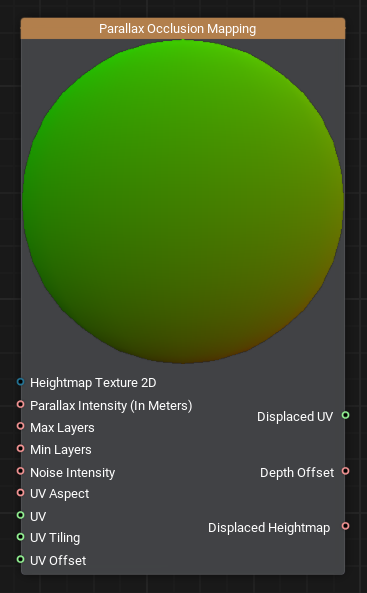Parallax Occlusion Mapping Node

Description
This node calculates a UV with a parallax effect offset for a certain UV channel.
Notice
In most cases it's enough using the simplified Parallax Simple node.
Ports
| Name | Description | |
|---|---|---|
 | Heightmap Texture 2D | Heightmap texture, where R channel stores concavity values. Black - maximum concavity, white - no parallax effect is applied. |
 | Parallax Intensity | Depth value (in meters) to which the surface is to be deepened visually if the corresponding texel of the heightmap is black. |
 | Max Layers | Number of parallax layers, when we look at the surface at a steep angle. Higher values increase quality but reduce performance. |
 | Min Layers | Number of parallax layers, when we look at the surface orthogonally. Higher values increase quality but reduce performance. |
 | Noise Intensity | Noise intensity value for building parallax layers in the [0, 1] range. |
 | UV Aspect | Texture aspect ratio. Should be equal to 1, for a square texture. |
 | UV | UV to which the parallax effect is to be applied. |
 | UV Tiling | Tiling of the texture. |
 | UV Offset | Offset for UV coordinates. |
 | Displaced UV | Parallaxed UVs for textures. |
 | Depth Offset | Depth offset value. |
 | Displaced Heightmap | Heightmap value displaced because of parallax effect. |
The information on this page is valid for UNIGINE 2.18.1 SDK.
Last update:
2024-04-19
Help improve this article
Was this article helpful?
(or select a word/phrase and press Ctrl+Enter)